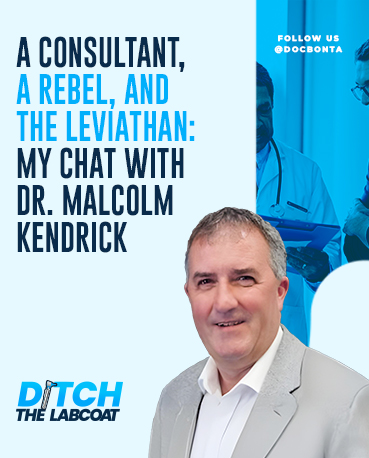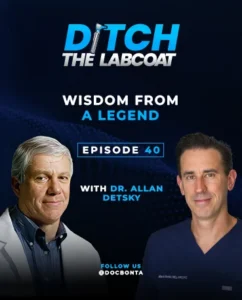If I had a dollar for every time I prescribed a statin, I’d probably own a moderately successful coffee shop by now. Maybe a place with decent espresso and an ironic name like The Lipid Lounge. But here I am, a consultant in General Internal Medicine, wrestling with a conversation I never thought I’d have – a spirited, somewhat unsettling, and thoroughly entertaining discussion with Dr. Malcolm Kendrick, the man who has spent years poking the proverbial cholesterol bear.
https://drmalcolmkendrick.org/
Now, let’s set the stage. I prescribe statins. A lot. I’ve done so for years, as per guidelines, protocols, and, let’s be honest, professional reflex. Heart attack? Statin. Stroke? Statin. High cholesterol? Statin. Mildly high cholesterol in an asymptomatic, well-functioning 82-year-old who walks five miles a day? Statin. Why? Because that’s what we do.
https://www.yalemedicine.org/news/should-you-take-a-statin-for-high-cholesterol
But Dr. Kendrick is not a fan. To put it lightly.
“Statins add 15 years to your life… in that they make you feel 15 years older.”
Well, that’s one way to grab an audience.
Dr. Kendrick, in his characteristically candid way, challenged the whole framework that has underpinned much of modern cardiovascular medicine – that lowering cholesterol with statins reduces meaningful cardiovascular events in a way that translates to better health outcomes. He broke it down: the absolute risk reduction in heart attacks from statins is about 1%, and the gain in life expectancy from five years of statin therapy is roughly… four days. Yes, four days. That’s assuming perfect adherence, no pesky side effects, and that you don’t spend those four days waiting in line at the pharmacy for your refill.
https://pmc.ncbi.nlm.nih.gov/articles/PMC8922205/
So, here I am, one foot firmly planted in my medical training, the other dangling precariously off the edge of professional self-doubt.
Because, to be honest, he’s not wrong.
The Leviathan of Medicine and the “Guideline Trance”
One of the biggest themes of our discussion was the sheer, unstoppable force of medical guidelines and the intricate web of pharmaceutical influence, academic research, and professional inertia that sustains them.
As physicians, we like to believe we’re independent thinkers, critical appraisers of literature, and evidence-based practitioners. And yet, most of us (myself included) follow guidelines with the kind of blind faith usually reserved for assembling IKEA furniture. The reasoning is straightforward:
- Guidelines exist for a reason.
- If you don’t follow them, you could be considered negligent.
- Following them means you’re practicing “standard of care,” which is legally, ethically, and professionally comfortable.
But what if the system that creates these guidelines is biased? What if the so-called “evidence” that supports widespread statin use is framed in a way that maximizes perceived benefit and minimizes harm? What if… I’ve been prescribing thousands of statins without really questioning whether they’re making a tangible difference in my patients’ lives?
Cue existential crisis.
https://journals.plos.org/plosmedicine/article?id=10.1371/journal.pmed.1001500
The Curse of LDL and the Future of LP(a)
Another hilarious (and slightly horrifying) moment came when we discussed lipoprotein(a) (LP(a)) – the cholesterol marker that has recently been gaining cult-like attention in the cardiology world.
LP(a) is, by all accounts, a better predictor of heart disease risk than LDL. It’s genetic, it’s unmodifiable by lifestyle, and – surprise! – there’s no treatment for it yet. But guess what? The pharmaceutical industry is already working on LP(a)-lowering drugs, and I’d bet my last prescription pad that, in a few years, we’ll be putting millions of people on them based on the same kind of data that built the statin empire.
We are watching history repeat itself in real time, except this time, the boogeyman isn’t just LDL – it’s LP(a). And soon enough, we’ll have another drug, another set of guidelines, and another well-meaning doctor (probably me) prescribing it reflexively.
Because once you realize how the game is played, you can’t unsee it.
So, What Do I Do Now?
As an internist, I live in the realm of practical medicine. I’m not a statin abolitionist. I still think they have a role in secondary prevention (i.e., if you’ve already had a heart attack or stroke). But our conversation made me pause and reflect on how I frame statin use to my patients.
Instead of the usual “Your cholesterol is high, here’s a statin,” I’m trying to shift the conversation to:
- “What matters most to you?”
- “Let’s talk about real, modifiable risk factors that impact your health far more than a cholesterol number – like smoking, exercise, stress, and sleep.”
- “Yes, statins might help, but here’s the actual magnitude of benefit, and here’s what to watch for in terms of side effects.”
Because when you break it down, most people would rather walk 30 minutes a day than take a pill for five years to gain four extra days of life.
Final Thoughts: Be Brave, Be Curious, and Maybe Read the Fine Print
Dr. Kendrick’s parting words were simple: Be brave. Question things. Look at the evidence for yourself.
And, frankly, he has a point. Medicine is a system, and systems resist change. It’s easier for everyone if doctors just follow the guidelines, patients take their meds without question, and pharmaceutical companies keep making billions. But real medicine – the kind that improves lives – happens in those moments where we slow down, think critically, and have honest, nuanced discussions.
So, am I still prescribing statins? Yes, but with a slightly guilty conscience and a newfound appreciation for their limits.
Am I rethinking the way I talk to my patients about cardiovascular risk? Absolutely.
And am I now worried that LP(a) is about to become the next cholesterol obsession? 100%.
So, to my colleagues, my patients, and anyone else who has ever emailed me their cholesterol results like it’s their kid’s report card: maybe it’s time we start looking beyond the numbers.
Signing off from the DTL studio.
Dr Mark Bonta




